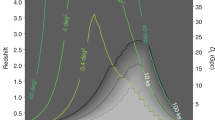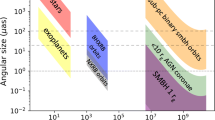Abstract
High throughput time-resolved observations of accreting collapsed objects at X-ray energies provide key information on the motions of matter orbiting a few gravitational radii away from black holes. Predictions of general relativity in the strong field regime, such as relativistic epicyclic motions, precession, light bending and the presence and radius of an innermost stable circular orbit in the close vicinity of a black hole can be verified by making use of two powerful diagnostics, namely relativistically broadened \(\hbox {Fe-K}\alpha \) lines and variability on dynamical timescales, quasi periodic oscillations in particular. Moreover tomography and reverberation techniques relying upon combined spectral timing and polarimetric timing provide an entirely new perspective in the field. Both the low and high spacetime curvature regimes of gravity can be probed by studying black holes of vastly different masses in X-ray binaries and Active Galactic Nuclei, opening up the possibility of testing also some alternative theories of gravity. To achieve these goals, very large area X-ray instrumentation with good spectral resolution and polarimetric capability is required. Prospects and projects in this area of research are briefly surveyed.











Similar content being viewed by others
Notes
The Athena mission, with its \(\sim 1\) \(\hbox {m}^2\) X-ray optics, will also have reverberation capabilities though mainly in the energy range below \(\sim 10\) keV [44]. It is planned for launch in the 2030s.
To be launched in 2020.
References
Abbott, B.P., Abbott, R., Abbott, T.D., Abernathy, M.R., Acernese, F., Ackley, K., Adams, C., Adams, T., Addesso, P., Adhikari, R.X.: Tests of general relativity with GW150914. Phys. Rev. Lett. 116(22), 221101 (2016). https://doi.org/10.1103/PhysRevLett.116.221101
Bambi, C.: Probing the space-time geometry around black hole candidates with the resonance models for high-frequency QPOs and comparison with the continuum-fitting method. JCAP 9, 014 (2012). https://doi.org/10.1088/1475-7516/2012/09/014
Bambi, C.: Measuring the Kerr spin parameter of a non-Kerr compact object with the continuum-fitting and the iron line methods. JCAP 8, 055 (2013). https://doi.org/10.1088/1475-7516/2013/08/055
Belloni, T.M., Stella, L.: Fast variability from black-hole binaries. Space Sci. Rev. 183, 43–60 (2014). https://doi.org/10.1007/s11214-014-0076-0
de La Calle Pérez, I., Longinotti, A.L., Guainazzi, M., Bianchi, S., Dovčiak, M., Cappi, M., Matt, G., Miniutti, G., Petrucci, P.O., Piconcelli, E., Ponti, G., Porquet, D., Santos-Lleó, M.: FERO: finding extreme relativistic objects. I. Statistics of relativistic \(\text{ Fe } \text{ K }_{\alpha }\) lines in radio-quiet Type 1 AGN. Astron. Astrophys. 524, A50 (2010). https://doi.org/10.1051/0004-6361/200913798
De Rosa, A., Uttley, P., Gou, L., Liu, Y., et al.: Accretion in Strong Field Gravity with eXTP. Sci. China Phys. Mech. Astron. (2018)
Dovčiak, M., Muleri, F., Goosmann, R.W., Karas, V., Matt, G.: Thermal disc emission from a rotating black hole: X-ray polarization signatures. MNRAS 391, 32–38 (2008). https://doi.org/10.1111/j.1365-2966.2008.13872.x
Fabian, A.C.: The innermost extremes of black hole accretion. Astron. Nachr. 337, 375 (2016). https://doi.org/10.1002/asna.201612316
Fabian, A.C., Rees, M.J., Stella, L., White, N.E.: X-ray fluorescence from the inner disc in Cygnus X-1. MNRAS 238, 729–736 (1989). https://doi.org/10.1093/mnras/238.3.729
Fabian, A.C., Vaughan, S., Nandra, K., Iwasawa, K., Ballantyne, D.R., Lee, J.C., De Rosa, A., Turner, A., Young, A.J.: A long hard look at MCG-6-30-15 with XMM-Newton. MNRAS 335, L1–L5 (2002). https://doi.org/10.1046/j.1365-8711.2002.05740.x
Feroci, M., Bozzo, E., Brandt, S., Hernanz, M., van der Klis, M., Liu, L.P., Orleanski, P., Pohl, M., Santangelo, A., Schanne, S., et al.: The LOFT mission concept: a status update. In: Space Telescopes and Instrumentation 2016: Ultraviolet to Gamma Ray, Proc. SPIE , vol. 9905, p. 99051R (2016). https://doi.org/10.1117/12.2233161
Feroci, M., Stella, L., Vacchi, A., Labanti, C., Rapisarda, M., et al.: LOFT: a large observatory for x-ray timing. In: Space telescopes and instrumentation 2010: ultraviolet to gamma ray, Proc. SPIE , vol. 7732, p. 77321V (2010). https://doi.org/10.1117/12.857337
Gierliński, M., Middleton, M., Ward, M., Done, C.: A periodicity of \(^{\sim }\)1hour in X-ray emission from the active galaxy RE J1034+396. Nature 455, 369–371 (2008). https://doi.org/10.1038/nature07277
Ingram, A., Done, C.: The effect of frame dragging on the iron K\(\alpha \) line in X-ray binaries. MNRAS 427, 934–947 (2012). https://doi.org/10.1111/j.1365-2966.2012.21907.x
Ingram, A., Maccarone, T.J., Poutanen, J., Krawczynski, H.: Polarization modulation from lense-thirring precession in X-ray binaries. Astrophys. J. 807, 53 (2015). https://doi.org/10.1088/0004-637X/807/1/53
Ingram, A., van der Klis, M., Middleton, M., Altamirano, D., Uttley, P.: Tomographic reflection modelling of quasi-periodic oscillations in the black hole binary H 1743–322. MNRAS 464, 2979–2991 (2017). https://doi.org/10.1093/mnras/stw2581
Ingram, A., van der Klis, M., Middleton, M., Done, C., Altamirano, D., Heil, L., Uttley, P., Axelsson, M.: A quasi-periodic modulation of the iron line centroid energy in the black hole binary H1743–322. MNRAS 461, 1967–1980 (2016). https://doi.org/10.1093/mnras/stw1245
Ingram, A.R., Maccarone, T.J.: An observational method for fast stochastic X-ray polarimetry timing. MNRAS 471, 4206–4217 (2017). https://doi.org/10.1093/mnras/stx1881
Iwasawa, K., Miniutti, G., Fabian, A.C.: Flux and energy modulation of redshifted iron emission in NGC 3516: implications for the black hole mass. MNRAS 355, 1073–1079 (2004). https://doi.org/10.1111/j.1365-2966.2004.08392.x
Johannsen, T.: Systematic study of event horizons and pathologies of parametrically deformed Kerr spacetimes. Phys. Rev. D 87(12), 124017 (2013). https://doi.org/10.1103/PhysRevD.87.124017
Johannsen, T.: X-ray probes of black hole accretion disks for testing the no-hair theorem. Phys. Rev. D 90(6), 064002 (2014). https://doi.org/10.1103/PhysRevD.90.064002
Johannsen, T., Psaltis, D.: Testing the no-hair theorem with observations in the electromagnetic spectrum. I. Properties of a Quasi-Kerr spacetime. Astrophys. J. 716, 187–197 (2010). https://doi.org/10.1088/0004-637X/716/1/187
Johannsen, T., Psaltis, D.: Testing the no-hair theorem with observations in the electromagnetic spectrum. III. Quasi-periodic variability. Astrophys. J. 726, 11 (2011). https://doi.org/10.1088/0004-637X/726/1/11
Kara, E., Alston, W.N., Fabian, A.C., Cackett, E.M., Uttley, P., Reynolds, C.S., Zoghbi, A.: A global look at X-ray time lags in Seyfert galaxies. MNRAS 462, 511–531 (2016). https://doi.org/10.1093/mnras/stw1695
Kramer, M., Stairs, I.H., Manchester, R.N., McLaughlin, M.A., Lyne, A.G., Ferdman, R.D., Burgay, M., Lorimer, D.R., Possenti, A., D’Amico, N., Sarkissian, J.M., Hobbs, G.B., Reynolds, J.E., Freire, P.C.C., Camilo, F.: Tests of general relativity from timing the double pulsar. Science 314, 97–102 (2006). https://doi.org/10.1126/science.1132305
LOFT Team: LOFT Assessment Study Report (Yellow Book): http://sci.esa.int/loft/53447-loft-yellow-book/. ESA/SRE 3, 1–108 (2013)
Maselli, A., Gualtieri, L., Pani, P., Stella, L., Ferrari, V.: Testing gravity with quasi-periodic oscillations from accreting black holes: the case of Einstein–Dilaton–Gauss–Bonnet theory. ApJ 801, 115 (2015). https://doi.org/10.1088/0004-637X/801/2/115
Maselli, A., Pani, P., Cotesta, R., Gualtieri, L., Ferrari, V., Stella, L.: Geodesic models of quasi-periodic-oscillations as probes of quadratic gravity. Astrophys. J. 843, 25 (2017). https://doi.org/10.3847/1538-4357/aa72e2
Miller, J.M., Fabian, A.C., Reynolds, C.S., Nowak, M.A., Homan, J., Freyberg, M.J., Ehle, M., Belloni, T., Wijnands, R., van der Klis, M., Charles, P.A., Lewin, W.H.G.: Evidence of black hole spin in GX 339–4: XMM-Newton/EPIC-pn and RXTE spectroscopy of the very high state. Astrophys. J. 606, L131–L134 (2004). https://doi.org/10.1086/421263
Motta, S.E., Belloni, T.M., Stella, L., Muñoz-Darias, T., Fender, R.: Precise mass and spin measurements for a stellar-mass black hole through X-ray timing: the case of GRO J1655–40. MNRAS 437, 2554–2565 (2014). https://doi.org/10.1093/mnras/stt2068
Padma, T.V.: Indian ASTROSAT telescope set for global stardom. Nature 525, 438–439 (2015). https://doi.org/10.1038/525438a
Psaltis, D.: Probes and tests of strong-field gravity with observations in the electromagnetic spectrum. Living Rev. Relat. 11, 9 (2008). https://doi.org/10.12942/lrr-2008-9
Remillard, R.A., Cackett, E., Fabian, A.C., Miller, J.M., Ranga Reddy Pasham, D., Steiner, J.F.: Observations of Black Hole Binaries with NICER. In: AAS/High Energy Astrophysics Division #16, AAS/High Energy Astrophysics Division, vol. 16, p. 104.07 (2017)
Reynolds, C.S.: Measuring black hole spin using X-Ray reflection spectroscopy. Space Sci. Rev. 183, 277–294 (2014). https://doi.org/10.1007/s11214-013-0006-6
Ryan, F.D.: Gravitational waves from the inspiral of a compact object into a massive, axisymmetric body with arbitrary multipole moments. Phys. Rev. D 52, 5707–5718 (1995). https://doi.org/10.1103/PhysRevD.52.5707
Stairs, I.H.: Testing general relativity with pulsar timing. Living Rev. Relat. 6, 5 (2003). https://doi.org/10.12942/lrr-2003-5
Stella, L.: Measuring black hole mass through variable line profiles from accretion disks. Nature 344, 747–749 (1990). https://doi.org/10.1038/344747a0
Stella, L., Vietri, M.: Lense-thirring precession and quasi-periodic oscillations in low-Mass X-Ray binaries. Astrophys. J. 492, L59–L62 (1998). https://doi.org/10.1086/311075
Stella, L., Vietri, M.: kHz Quasiperiodic oscillations in low-mass X-Ray binaries as probes of general relativity in the strong-field regime. Phys. Rev. Lett. 82, 17–20 (1999). https://doi.org/10.1103/PhysRevLett.82.17
Stella, L., Vietri, M., Morsink, S.M.: Correlations in the quasi-periodic oscillation frequencies of low-mass X-Ray binaries and the relativistic precession model. Astrophys. J. 524, L63–L66 (1999). https://doi.org/10.1086/312291
Syunyaev, R.A.: Variability of X-rays from black holes with accretion disks. Astrophys. J. 49, 1153 (1972)
Tanaka, Y., Nandra, K., Fabian, A.C., Inoue, H., Otani, C., Dotani, T., Hayashida, K., Iwasawa, K., Kii, T., Kunieda, H., Makino, F., Matsuoka, M.: Gravitationally redshifted emission implying an accretion disk and massive black hole in the active galaxy MCG-6-30-15. Nature 375, 659–661 (1995). https://doi.org/10.1038/375659a0
Treves, A., Maraschi, L., Abramowicz, M.: Basic elements of the theory of accretion. PASP 100, 427–451 (1988). https://doi.org/10.1086/132189
Uttley, P., Cackett, E.M., Fabian, A.C., Kara, E., Wilkins, D.R.: X-ray reverberation around accreting black holes. Astron. Astrophys. Rev. 22, 72 (2014). https://doi.org/10.1007/s00159-014-0072-0
van der Klis, M.: Rapid X-ray variability. In: Lewin, W.H.G., van der Klis, M. (eds.) Compact Stellar X-ray Sources, pp. 39–112. Cambridge University Press, Cambridge (2006)
Weisskopf, M.C., Ramsey, B., O’Dell, S., Tennant, A., Elsner, R., Soffitta, P., Bellazzini, R., Costa, E., Kolodziejczak, J., Kaspi, V., Muleri, F., Marshall, H., Matt, G., Romani, R.: The Imaging X-ray Polarimetry Explorer (IXPE). In: Space Telescopes and Instrumentation 2016: Ultraviolet to Gamma Ray, Proc. SPIE , vol. 9905, p. 990517 (2016). https://doi.org/10.1117/12.2235240
Wilson-Hodge, C.A., Ray, P.S., Gendreau, K., Chakrabarty, D., Feroci, M., Arzoumanian, Z., Brandt, S., Hernanz, M., Hui, C.M., Jenke, P.A., Maccarone, T., Remillard, R., Wood, K., Zane, S.: Strobe-X collaboration: STROBE-X: X-ray timing and spectroscopy on dynamical timescales from microseconds to years. Results Phys. 7, 3704–3705 (2017). https://doi.org/10.1016/j.rinp.2017.09.013
Zhang, S.N., Feroci, M., Santangelo, A., Dong, Y.W., Feng, H., Lu, F.J., Nandra, K., Wang, Z.S., Zhang, S., Bozzo, E., Brandt, S., De Rosa, A., Gou, L.J., Hernanz, M., van der Klis, M., et al.: eXTP: Enhanced X-ray Timing and Polarization mission. In: Space Telescopes and Instrumentation 2016: Ultraviolet to Gamma Ray, Proc. SPIE , vol. 9905, p. 99051Q (2016). https://doi.org/10.1117/12.2232034
Acknowledgements
I acknowledge many useful discussions with and numerous inputs from members of the LOFT, eXTP and STROBE-X collaborations; I am especially indebted to Enrico Bozzo, Alessandra De Rosa, Marco Feroci, Adam Ingram, Michiel van der Klis, Leonardo Gualtieri, Andrea Maselli and Phil Uttley. Alessandra De Rosa provided also comments on an earlier version of this review. The author acknowledges financial contribution from ASI-INAF Agreement n.2017-14-H.O.
Author information
Authors and Affiliations
Corresponding author
Rights and permissions
About this article
Cite this article
Stella, L. Probing the Strong (Stationary) Gravitational Field of Accreting Black Holes with X-ray Observations. Found Phys 48, 1500–1516 (2018). https://doi.org/10.1007/s10701-018-0212-x
Received:
Accepted:
Published:
Issue Date:
DOI: https://doi.org/10.1007/s10701-018-0212-x




